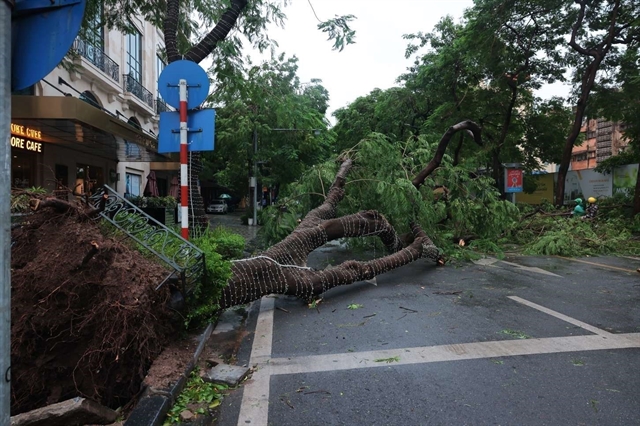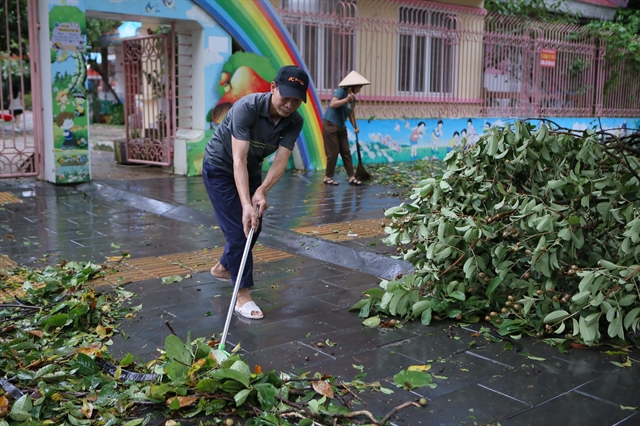At least 14 killed, 176 injured by super typhoon Yagi
Society – Economy - Ngày đăng : 15:26, 08/09/2024
 |
| A big tree is uprooted on Lý Lường Kiệt Street in Hà Nội. VNA/VNS Photos |
HÀ NỘI — Super typhoon Yagi that swept through northern mountainous localities over the weekend killed at least 14 people and injured 176 others, according to the information updated at 10am on Sunday by the Ministry of Agriculture and Rural Development.
Among the dead, four were from Quảng Ninh Province, three from Hà Nội, one from Hải Phòng City, one from Hải Dương Province, one from Military Region 3 and four from the same family in Hòa Bình Province who died during landslides on Sunday early morning.
Most of the injured victims were from Quảng Ninh Province.
Twenty-five small cement and timber ships sank at their anchorage in Quảng Ninh Province.
Thirteen fishermen went missing including seven people on Tiến Thành 05 ship and six people on Hồng Gai sea tugboat which broke anchor and drifted without contact, according to the National Steering Committee for Natural Disaster Prevention and Control.
Five localities which suffered the most damage from the typhoon – Quảng Ninh, Hải Phòng, Thái Bình, Hải Dương, and Hà Nội – reported extensive power outages.
Chairing a meeting to overcome the super typhoon’s consequences on Sunday morning, Prime Minister Phạm Minh Chính said Typhoon Yagi and its circulation were assessed to leave a wide range of influence on 26 localities from the northern region to Thanh Hóa Province.
Yagi made landfall in Việt Nam and caused serious devastation for over one day. Torrential rain and floods are still forecast in the northern mountainous region.
 |
| People in Nam Định Province clean up on Sunday morning after the typhoon hit the northern region. |
PM Chính asked relevant agencies to review and offer assistance to localities that suffer from losses and families of the deceased.
He called for urgent typhoon recovery actions and directed mobile and electricity network operators to cooperate and share network connections.
Strong winds and heavy rain damaged 3,279 houses and left 401 electricity poles to collapse.
Many stores, offices and schools had their roofs blown off or were damaged. A number of advertising signs and telecommunication poles were broken.
About 121,500ha of rice and farm produce crops were destroyed, mostly in Thái Bình, Hải Dương, Bắc Ninh provinces, Hà Nội and Hải Phòng City.
Over 1,000 fish cafes were damaged or blown away in the typhoon, mostly in the coastal province of Quảng Ninh.
According to the National Centre for Hydro-Meteorological Forecasting, after the typhoon weakened into a tropical depression, heavy rain is predicted to continue on Sunday and Monday in the entire plains, midlands and mountainous areas of the north, with an average 24-hour rainfall of up to 100-150mm, and in some places over 200mm.
There is a high risk of flooding on rivers and streams and flash floods and landslides in some localities.
Urban areas still stand a high risk of flooding.
Eighteen northern provinces have been warned of flash floods and landslides.
Meteorological experts warn that flash floods and landslides can have negative impacts on the environment, threaten people's lives, cause local traffic jams, affect the movement of vehicles and damage production and socio-economic activities.
Affected localities need to regularly monitor real-time warnings of areas at risk of flash floods and landslides updated online on the website of the General Department of Hydrometeorology at https://luquetsatlo.nchmf.gov.vn and in separate bulletins.
Recovery efforts
Joint efforts between local authorities and residents have been underway across the region since Sunday morning after the typhoon weakened into a tropical depression on Sunday morning.
Traffic around Hà Nội on Sunday was disrupted by fallen trees, blocking all or part of the roadway.
Many families had to mobilise the support of neighbours to deal with water flooding into their homes, Tiền Phong (Vanguard) newspaper reported.
In some hallways, water flooded through the cracks in the glass doors and flowed onto the floor. Building management staff and residents had to take turns to clean the floors and prevent water from flowing into the elevators.
At the Gelexia apartment building in Hoàng Mai District, a family had to take turns bringing clothes and towels to soak up the water flowing into the house through the cracks in the glass windows.
Nguyễn Văn Dũng, a resident at @Home apartment building in Hoàng Mai District, told Tiền Phong: “The wind was howling, the glass door separating the living room and the balcony was shaking. Water poured through the cracks in the door into the house, flooding the living room, bedrooms and kitchen area. I have never seen such strong winds in more than 20 years of living in the capital city.”
From 3pm on Saturday until 5am on Sunday, the city reported rainfall from 100 to 220mm in most of the inner districts, according to the Hà Nội Sewerage And Drainage Ltd Company.
The company has arranged mobile pumps and suction trucks to drain the water.
From 5am on Sunday, the company has arranged workers to clean up the intakes and barriers, focusing on operating the main pumping stations to keep the water level in the system at the lowest level, ready to receive and transport water when heavier rain occurs.
To prevent flooding, the company will continue to operate pumping stations on the system and sluice gates of Đống Đa, Bảy Mẫu, Đầm Chuối lakes to lower the water level.
Speaking to the press on Sunday morning, Bùi Thị Minh Hoài, Secretary of the city Party Committee, said local authorities have taken drastic measures to respond to the typhoon, for example, promptly evacuating people from dangerous old apartment buildings, arranging safe shelters, mobilising forces on duty to support locals during the typhoon. Thanks to those efforts, the city basically still ensures the key goals, especially keeping people safe.
In Quảng Ninh Province, Cao Tường Huy, chairman of the provincial People’s Committee, said the damages and fatalities caused by the typhoon have not been fully determined due to the widespread impact of broken 110KV power poles and lost information connection.
The province has mobilised all sectors, localities, police, army and people to focus on cleaning up to soon stabilise people's lives.
He proposed to the Prime Minister that the province’s power system must first be restored to connect communications.
Forty-six people stranded at sea and on islands have been safely brought to shore.
Local authorities also proposed that the Government support helicopters for searching people and vehicles missing at sea.
Since early Sunday morning, residents of Hạ Long City, Quảng Ninh Province poured into the streets to start cleanup work.
Trần Thị Vân, living in Cao Thắng Ward witnessed the storm sweeping through Hạ Long. She said her family was so scared that they had to run down to the basement of a solid building near their house to take shelter from the storm. At first, the wind was strong, then heavy rain caused flooding, and the family was so scared that they stayed up all night.
Nguyễn Văn Quyền, from the same ward, said although his family did not suffer any damage, he took the initiative early in the morning to join the neighborhood to clean up the streets.
He said the cleanup work to overcome the typhoon’s consequences might take several weeks.
Local authorities and sectors in other localities are also mobilising forces to urgently mitigate the damage, assess losses, and support residents in stabilising their daily lives.
The Ministry of Industry and Trade has instructed power companies to assess the damage and promptly restore power grids, prioritising the electricity supply to key enterprises and industrial zones.
The Ministry of National Defence and the Ministry of Information and Communications have directed telecommunications firms to quickly restore communication networks.
The Ministry of Industry and Trade and the Ministry of Natural Resources and Environment have provided guidance on managing reservoir operations to prevent compound flooding. — VNS
